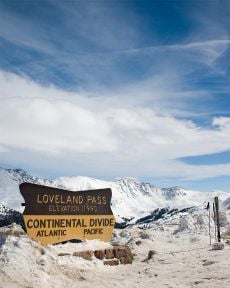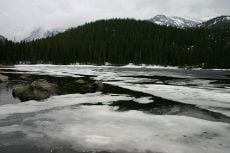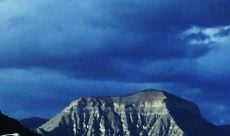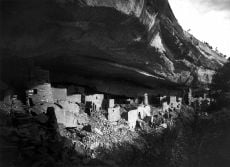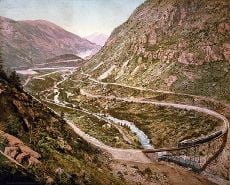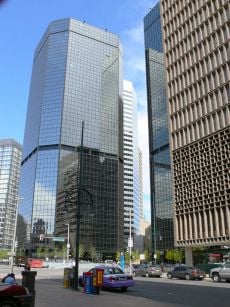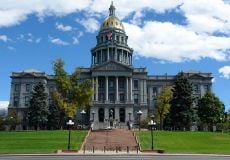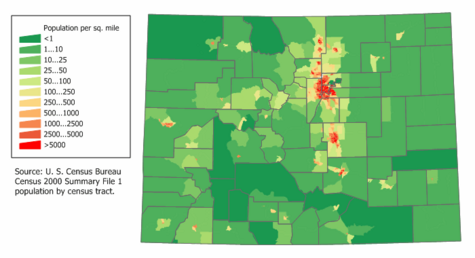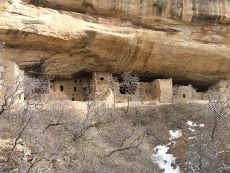Difference between revisions of "Colorado" - New World Encyclopedia
Vicki Phelps (talk | contribs) |
Vicki Phelps (talk | contribs) |
||
| Line 193: | Line 193: | ||
The two current U.S. [[United States Senate|Senators]] from Colorado are Wayne Allard (R), and Ken Salazar (D). The state has seven U.S. Congressional districts, based on the 2000 Census. | The two current U.S. [[United States Senate|Senators]] from Colorado are Wayne Allard (R), and Ken Salazar (D). The state has seven U.S. Congressional districts, based on the 2000 Census. | ||
| − | ==Cities and Towns== | + | ==Demographics== |
| + | The state's most populous city, and capital, is [[Denver, Colorado|Denver]]. The Denver-Aurora-Boulder Combined Statistical Area, home to 2,927,911 people, contains more than two-thirds of the state's population. Residents of Colorado are properly referred to as ''Coloradans'', although the term ''Coloradoans'' is still used.<ref>{{cite web |author=Merriam Webster |title=Definition of Colorado |url=http://m-w.com/dictionary/colorado |accessdate=2006-09-26}}</ref><ref name=Coloradan>{{cite web | date = [[2007-08-01]] | url = http://ccs.colostate.edu/index.asp?url=style_guide_az#state_names | title = Writer's Style Guide | format = [[HTML]] | publisher = [[Colorado State University]], Communications & Creative Services | accessdate = 2008-05-07}}</ref> | ||
| + | |||
| + | As of 2005, Colorado has an estimated population of 4,665,177, which is an increase of 63,356, or 1.4%, from the prior year and an increase of 363,162, or 8.4%, since the year 2000. This includes a natural increase since the last census of 205,321 people (that is 353,091 births minus 147,770 deaths) and an increase due to net migration of 159,957 people into the state. [[Immigration to the United States|Immigration]] from outside the United States resulted in a net increase of 112,217 people, and [[Human migration|migration]] within the country produced a net increase of 47,740 people. | ||
| + | |||
| + | The largest increases are expected in the [[Front Range Urban Corridor]], especially in the [[Denver metropolitan area]]. The state's fastest growing counties are [[Douglas County, Colorado|Douglas]] and [[Park County, Colorado|Park]]. Both counties had been suburbanized or grew by 5 times in population in the 1990s and early 2000s. Large numbers of new residents in the state originate from [[California]], which led some locals to feel that their state was "[[Californication (portmanteau)|Californicated]]" in the 1990s (esp. Denver resembled more of [[Los Angeles]]) when real estate home prices, lower cost of living and a healthier economy in growth rates drew in over 100,000 Californians at the time, and there are others moved in from East Coast states. The [[center of population]] of Colorado is located just north of the town of Critchell in [[Jefferson County, Colorado|Jefferson County]].<ref>http://www.census.gov/geo/www/cenpop/statecenters.txt</ref> | ||
| + | |||
| + | [[Image:Colorado population map.png|thumb|left|475px|Colorado Population Density Map]] | ||
| + | |||
| + | Colorado has one of the highest proportions of [[Hispanic]] citizens of any U.S. state; only five states have a higher percentage. Denver and some other areas have significant [[Mexican American|Mexican]] populations, while southern Colorado has a large number of [[Hispanos]], the descendants of early New Mexican settlers of colonial [[Spanish people|Spanish]] origin. The [[2000 U.S. Census]] reports that 10.52% of people aged 5 and over in Colorado speak [[Spanish language|Spanish]] at home.<ref>[http://www.mla.org/map_data_results&state_id=8&mode=state_tops&order=r Language Map Data Center<!-- Bot generated title —>]</ref> Colorado, like [[New Mexico]], is very rich in archaic Spanish idioms.<ref>[http://www.elcastellano.org/palabra.php?id=946 Elcastellano.org talking about Colorado in "nada"]</ref> | ||
| + | |||
| + | Colorado has a history of African-Americans communities which are located in northeast Denver in the Montbello, Green Valley Ranch, Park Hill and Colfax Park areas. The state has sizable numbers of Asian-Americans of [[Chinese American|Chinese]], [[Filipino people|Filipino]], [[Koreans|Korean]], [[Southeast Asian]] and [[Japanese American|Japanese]] descent. The Denver metropolitan area is considered more liberal and diverse than much of the state when it comes to political issues and environmental concerns, as the Denver area rapidly grows in size, sprawl and population in the last 40 years. | ||
| + | |||
| + | According to the 2000 Census, the largest ancestry groups in Colorado are [[Germans|German]] (22%) including of [[Swiss people|Swiss]] and [[Austria]]n nationalities, [[Irish people|Irish]] (12.2%), and [[English people|English]] (12%). Persons reporting [[German American|German ancestry]] are the largest group in the state and are especially strong in the Front Range, the Rockies (west-central counties) and Eastern parts/High Plains.<ref>[http://www.mapquest.com/maps/map.adp?searchtype=address&formtype=address&latlongtype=decimal&latitude=39.500656&longitude=-105.203628 Map of Latitude: 39.500656 Longitude: -105.203628, by MapQuest<!-- Bot generated title —>]</ref> Denver and nearby areas on the Front Range has sizable [[Scandinavian people|Scandinavian]], [[Italian American|Italian]], [[Slavic]] and [[American Jewish|Jewish]] American communities, partly a legacy of [[gold rush]]es in the late 19th century (1861-1889). | ||
| + | <center>{{US Demographics}}</center> | ||
| + | |||
| + | There were a total of 70,330 births in Colorado in 2006. (Birth Rate of 14.6). Although Non-Hispanic Whites constituted 73.5% of the population they accounted for only 48.90% of all the births. The first time in state history with the statistic of non-Hispanic whites have less babies. But 14.06% of the births happened to parents of different races (About two-thirds to White-Latino parents).<ref>[http://www.cdphe.state.co.us/scripts/htmsql.exe/cohid/natalityPub.hsql CDPHE: COHID Birth Data Request<!-- Bot generated title —>]</ref> Westernmost counties where the majority of residents are adherents of [[Mormonism]] there's a slightly higher percentage of families with children and those of under age 18. | ||
| + | |||
| + | [[Image:Colorado Rocky Mtn Church.jpg|thumb|upright|The Chapel on the Rock at Camp Saint Malo near [[Allenspark, Colorado|Allenspark]].]] | ||
| + | [[Image:Great Stupa of Dharmakaya 1.jpg|thumb|upright|The [[stupa|Great Stupa]] of [[Dharmakaya]] near [[Red Feather Lakes, Colorado|Red Feather Lakes]].]] | ||
| + | [[Image:USAFA Chapel from terrazzo.JPG|thumb|upright|The Cadet Chapel at the [[United States Air Force Academy]] near [[Colorado Springs, Colorado|Colorado Springs]].]] | ||
| + | Colorado has a higher number of younger persons in median age: 33, according to the 2000 Census report. Large numbers of married couples in professional careers with young children move to the state in a belief it's a better place to raise a family. Colorado is also a major retirement destination by [[senior citizens]] in search of a warmer climate, recreation activities and the higher altitude in most of Colorado is said to provide health benefits for those with respiratory diseases. | ||
| + | |||
| + | ===Religion=== | ||
| + | Colorado's population is predominately [[Christianity|Christian]], although it has a high percentage of religiously unaffiliated residents like most other Western states. Colorado, and specifically the [[Colorado Springs, Colorado|City of Colorado Springs]], serves as the headquarters of numerous Christian groups, many of them [[Evangelicalism#Evangelicalism_in_the_United_States|Evangelical]]. [[Focus on the Family (United States)|Focus on the Family]] is a major conservative Christian organization headquartered in Colorado Springs. [[Roman Catholic Church|Catholicism]] is popular in Colorado, and is becoming more so with the influx of Latino [[immigrants]]. | ||
| + | |||
| + | Major religious affiliations of the people of Colorado are:<ref>[http://religions.pewforum.org/maps U.S. Religion Map and Religious Populations - U.S. Religious Landscape Study - Pew Forum on Religion & Public Life<!-- Bot generated title —>]</ref> | ||
| + | *[[Christianity|Christian]] – 65% | ||
| + | **[[Protestantism|Protestant]] – 44% | ||
| + | ***[[Evangelicalism#Evangelicalism_in_the_United_States|Evangelical]] – 23% | ||
| + | ***[[Mainline (Protestant)|Mainline]] – 19% | ||
| + | ***Other Protestant – 2% | ||
| + | **[[Roman Catholicism in the United States|Roman Catholic]] – 19% | ||
| + | **[[The Church of Jesus Christ of Latter-day Saints|Latter Day Saint]] – 2% | ||
| + | *[[Jewish]] – 2% | ||
| + | *[[Muslim]] – 1% | ||
| + | *Other Religions – 1% | ||
| + | *Unaffiliated – 31% | ||
| + | |||
| + | The largest denominations by number of adherents in 2000 were the [[Roman Catholic Church]] with 752,505; the [[Church of Jesus Christ of Latter-day Saints]] with 92,326; and the [[Southern Baptist Convention]] with 85,083. <ref>http://www.thearda.com/mapsReports/reports/state/08_2000.asp</ref> | ||
| + | |||
| + | ===Cities and Towns=== | ||
Colorado has 271 incorporated municipalities and 83 active United States Census Designated Places.<ref name=COmuniStatus>{{cite web | date = [[2006-09-18]] | url = http://www.dola.state.co.us/LGS/localgovtinfo/municipalities.htm | title = Active Colorado Municipalities as of September 18, 2006 | format = [[HTML]] | publisher = State of Colorado, Department of Local Affairs | accessdate = 2007-01-08 }}</ref><ref name=Census2000Places>{{cite web | date = 2000 | url = http://www.census.gov/tiger/tms/gazetteer/places2k.txt | title = Census 2000 Places | format = [[text file]] | work = Census 2000 U.S. Gazetteer Files | publisher = U.S. Census Bureau, Population Division | accessdate = 2007-01-08 }}</ref> | Colorado has 271 incorporated municipalities and 83 active United States Census Designated Places.<ref name=COmuniStatus>{{cite web | date = [[2006-09-18]] | url = http://www.dola.state.co.us/LGS/localgovtinfo/municipalities.htm | title = Active Colorado Municipalities as of September 18, 2006 | format = [[HTML]] | publisher = State of Colorado, Department of Local Affairs | accessdate = 2007-01-08 }}</ref><ref name=Census2000Places>{{cite web | date = 2000 | url = http://www.census.gov/tiger/tms/gazetteer/places2k.txt | title = Census 2000 Places | format = [[text file]] | work = Census 2000 U.S. Gazetteer Files | publisher = U.S. Census Bureau, Population Division | accessdate = 2007-01-08 }}</ref> | ||
{{-}} | {{-}} | ||
Revision as of 18:51, 6 November 2008
Template:US stateThe State of Colorado is a state located in the Rocky Mountain region of the United States of America. Colorado may also be considered to be a part of the Western and Southwestern regions of the United States. The United States Census Bureau estimates that the state population was 4,861,515 in 2007, a 13.03% increase since the U.S. Census 2000.[1] Denver is the capital as well as the most populous city of Colorado. Citizens of Colorado are known as Coloradans.
Geography
The State of Colorado is defined as the geoellipsoidal rectangle that stretches from 37°N to 41°N latitude and from 102°03'W to 109°03'W longitude (25°W to 32°W from the Washington Meridian).[2] Colorado, Wyoming, and Utah are the only three U.S. states that have only lines of latitude and longitude for boundaries and that have no natural borders. When government surveyors established the border markers for the Territory of Colorado, minor surveying errors created several small kinks along the borders, most notably along the border with the Territory of Utah. The surveyors' benchmarks, once agreed upon by the interested parties, became the legal boundaries for the Colorado Territory.[3]
The summit of Mount Elbert at 14,440 feet (4,401 m) elevation in Lake County is the state's highest point and the highest point in the entire Rocky Mountains.[4][5] Colorado has more than 50 mountain peaks that exceed 4,000 meters (13,123 ft) elevation. Colorado is the only U.S. state that lies entirely above 1,000 meters (3,281 ft) elevation. The point where the Arikaree River flows out of Yuma County, Colorado, and into Cheyenne County, Kansas, is the lowest point in the State of Colorado at 3,315 feet (1,010 m) elevation. This crossing point holds the distinction of being the highest low point of any U.S. state.[6][4]
Nearly half of the state is flat in stark contrast to Colorado's rugged Rocky Mountains. East of the Southern Rocky Mountains are the Colorado Eastern Plains of the High Plains, the section of the Great Plains within Colorado at elevations ranging from 3,315 to 6,562 feet (1,010 to 2,000 m). The states of Kansas and Nebraska border Colorado to the east. The plains are sparsely settled, with most population along the South Platte and the Arkansas rivers. Precipitation is meager, averaging from 12 to 18 inches (300 to 450 mm) annually. There is some irrigated farming, but much of the land is used for dryland farming or ranching. Winter wheat is a typical crop and most small towns in the region boast both a water tower and a grain elevator.
The bulk of Colorado's population lives along the eastern edge of the Rocky Mountains in the Front Range Urban Corridor. This region is partially protected from prevailing storms by the high mountains to the west.
To the west lies the eastern slope of the Rocky Mountains with notable peaks such as Longs Peak, Mount Evans, Pikes Peak, and the Spanish Peaks near Walsenburg in the south. This area drains to the east, is forested, and partially urbanized. During the drought of 2002 devastating forest fires swept this area.
The Continental Divide stretches across the crest of the Rocky Mountains. To the west of the Continental Divide is the Western Slope. Water west of the Continental Divide drains west into the Sea of Cortez via the Colorado River.
Within the interior of the Rocky Mountains are several large parks or high broad basins. In the north, on the east side of the Continental Divide is North Park. North Park is drained by the North Platte River, which flows north into Wyoming. Just south but on the west side of the Continental Divide is Middle Park, drained by the Colorado River. South Park is the headwaters of the South Platte River. To the south lies the San Luis Valley, the headwaters of the Rio Grande, which drains into New Mexico. Across the Sangre de Cristo Range to the east of the San Luis Valley lies the Wet Mountain Valley. These basins, particularly the San Luis Valley, lie along the Rio Grande Rift, a major geological formation, and its branches.
The Rocky Mountains within Colorado contain 53 peaks that are 14,000 feet (4,267 m) or higher elevation, known as fourteeners. The mountains are timbered with conifers and aspen to the tree line, at an elevation of about 12,140 feet (3,700 m) in southern Colorado to about 10,500 feet (3,200 m) in northern Colorado; above this only alpine vegetation grows. The Colorado Rockies are snow-covered only in the winter; most snow melts by mid-August with the exception of a few small glaciers. The Colorado Mineral Belt, stretching from the San Juan Mountains in the southwest to Boulder and Central City on the front range, contains most of the historic gold- and silver-mining districts of Colorado.
The Western Slope is generally drained by the Colorado River and its tributaries. Notable to the south are the San Juan Mountains, an extremely rugged mountain range, and to the west of the San Juans, the Colorado Plateau, a high desert bordering Southern Utah. Grand Junction is the largest city on the Western Slope. Grand Junction is served by Interstate Highway I-70. To the southeast of Grand Junction is Grand Mesa, the world's largest flat-topped mountain. Further east are the ski resorts of Aspen, Vail, Crested Butte, and Steamboat Springs. The northwestern corner of Colorado bordering Northern Utah and Western Wyoming is mostly sparsely populated rangeland.
From west to east, the state consists of desert-like basins, turning into plateaus, then alpine mountains, and then the grasslands of the Great Plains. The famous Pikes Peak is just west of Colorado Springs. Its lone peak is visible from near the Kansas border on clear days.
Colorado is also one of only four states in the United States to share a common border (Four Corners), along with Arizona, New Mexico and Utah. At this intersection, it is possible to stand in four states at once.
Climate
The climate of Colorado is quite complex compared to most of the United States. The typical south-north/cooler-warmer variation in other states is not generally applicable in Colorado. Mountains and surrounding valleys greatly affect local climate. As a general rule, with an increase in elevation come a decrease in temperature and an increase in precipitation. A main climatic division in Colorado occurs between the Rocky Mountains on the west and the plains on the east; the foothills form a transitional zone between the two.
Eastern Plains
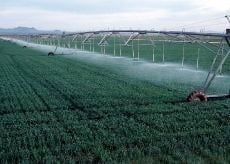
The climate of the Eastern Plains is a semi-arid continental climate (Koppen climate classification BSk) of low humidity and moderately low precipitation, usually from 10 to 15 inches (250 to 380 mm) annually. The area is known for its abundant sunshine and cool clear nights, which give this area the highest average diurnal temperature range in the United States. In summer, this area can have many days above 95 °F (35 °C) and sometimes 100 °F (38 °C), although 105 °F (41 °C) is the maximum in the front range cities above 5000 ft (1500 m). In those areas, −25 °F (−31.7 °C) is the all-time record low. About 75% of the precipitation falls within the growing season, from April to September, but this area is very prone to droughts. Most of the precipitation comes in the form of thunderstorms, which are often severe, and the form of major snowstorms that happen most often in the early spring and in late autumn, and sometimes winter, from low pressures that bring the right conditions. Otherwise, winters tend to be drier and cold, even though it's known for having a number of mild days in many winters. In much of this region, March and April are the snowiest months. April and May are normally the rainiest months, while April is the wettest month that has the most combination of rain and snow. The Front Range cities closer to the mountains tend to be warmer in the winter due to chinook winds which warm the area, sometimes bringing temperatures up to 60 °F (16 °C) or higher in the winter.[7] The average July temperature is 57 degrees in the morning and 87 degrees in the afternoon. The average January temperature is 15 degrees in the morning and 43 degrees in the afternoon, although the daily high may be 60 one day and 0 the next.
West of the plains and foothills
West of the plains and foothills, the weather of Colorado is much less uniform. Even places a few miles (kilometers) apart can experience entirely different weather, depending on the topography of the area. Most valleys also have a semi-arid climate, which becomes an alpine climate at higher elevations. Generally, the wettest season is in the winter in Western Colorado while June is the driest month, which is the opposite of precipitation patterns in the east. The mountains have cool summers with many days of high temperatures around 60 °F (16 °C) and 70 °F (21 °C), although frequent thunderstorms can cause a sudden drop in temperatures. Summer nights are cool, and cold at the highest altitudes which can sometimes bring snow even in the middle of the summer. The winters bring abundant, powdery snowfall to the mountains which the skiers love, although even in the winter, there can be many days with abundant sunshine in between major storms. The Western Slope has high summer temperatures similar to those found on the plains while the winters tend to be slightly cooler due to the lack of any warming winds which are common in the plains and Front Range. Other areas in the west have their own unique climate. The San Luis Valley is generally dry with little rain or snow, although the snow that falls tends to stay on the ground all winter.
Extreme weather
Extreme weather is a common occurrence in Colorado. Thunderstorms are common east of the Continental divide in the spring and summer, and Colorado is one of the leading states in deaths due to lightning. Hail is a common sight in the mountains east of the divide and in the northwest part of the state. While not as common as some of the states to the east, much of the Eastern Plains are prone to tornadoes, and there have been some damaging tornadoes there. An example is the 1990 Limon F3 tornado and the 2008 Windsor F3 tornado which devastated the city. Floods are also a factor in the plains, not just from the thunderstorms, but also due to heavy snow in the mountains followed by a warm, dry period which swells rivers with melted snow. In 2008, from July through August, a new record was set that was previously held in 1901 of twenty-three straight days of 90 degree heat, surpassing the previous record by almost a week. Colorado is also known for its droughts that occur every few years, causing major wildfires such as the Hayman Fire, one of the largest wildfires in US history.
Records
The highest temperature ever recorded in Colorado was 118 °F (48 °C) on July 11, 1888, at Bennett, while the lowest was -61 °F (-52 °C) on February 1, 1985, at Maybell.[8][9]
History
The region that is today the State of Colorado has been inhabited by Native Americans for more than 13 millennia. The Lindenmeier Site in Larimer County contains artifacts dating from approximately 11200 B.C.E. to 3000 B.C.E. The Ancient Pueblo Peoples lived in the valleys and mesas of the Colorado Plateau. The Ute Nation inhabited the mountain valleys of the Southern Rocky Mountains and the Western Rocky Mountains. The Arapaho Nation and the Cheyenne Nation moved west to hunt across the High Plains.
The United States acquired a territorial claim to the eastern flank of the Rocky Mountains with the Louisiana Purchase from France in 1803. The U.S. claim conflicted with Spain's claim that a huge region surrounding its colony of Santa Fé de Nuevo Méjico was its sovereign trading zone. Zebulon Pike led a U.S. Army reconnaissance expedition into the disputed region in 1806. Pike and his men were arrested by Spanish cavalry in the San Luis Valley the following February, taken to Chihuahua, and expelled from México the following July.
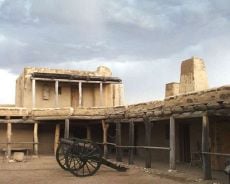
The United States relinquished its claim to all land south and west of the Arkansas River as part of the U.S. purchase of Florida from Spain with the Adams-Onís Treaty of 1819. México finally won its independence from Spain in 1821, but it surrendered its northern territories to the United States after the Mexican-American War with the Treaty of Guadalupe Hidalgo in 1848. In 1849, the Mormons of Deseret (now Utah) organized the extralegal Provisional State of Deseret which claimed all land drained by the Green River and the Colorado River. The federal government refused to recognize the new government, and the Mormons declined to settle east of the Green River for more than 20 years. The United States divided the area of the future Colorado among the Territory of New Mexico and the Territory of Utah organized in 1850, and the Territory of Kansas and the Territory of Nebraska organized in 1854.
Most American settlers traveling west to Oregon, Deseret, or California avoided the rugged Rocky Mountains and instead followed the North Platte River and Sweetwater River through what is now Wyoming. On 1851-04-09, Hispanic settlers from Taos, New Mexico, settled the village of San Luis, then in the New Mexico Territory, but now Colorado's first permanent European settlement. Gold was discovered along the South Platte River in western Kansas Territory in July 1858, precipitating the Pike's Peak Gold Rush.[10] The placer gold deposits along the rivers and streams of the region rapidly played out, but miners soon discovered far more valuable seams of hard rock gold, silver, and other minerals in the nearby mountains.
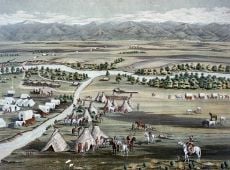
The Provisional Government of the Territory of Jefferson was organized on 1859-10-24, but the new territory failed to secure federal sanction. The election of Abraham Lincoln for U.S. President on 1860-11-06, led to the secession of six slave states and the threat of civil war. Seeking to augment the political power of the free states, the Republican led U.S. Congress hurriedly admitted the eastern portion of the Territory of Kansas to the Union as the free State of Kansas on 1861-01-29, leaving the western portion of the territory, and its gold fields, unorganized.
Thirty days later on 1861-02-28, outgoing U.S. President James Buchanan signed an act of Congress organizing the free Territory of Colorado.[11] The original boundaries of Colorado remain unchanged today. The name Colorado was chosen because it was commonly believed that the Colorado River originated in the territory.[12] Early Spanish explorers named the river the Rio Colorado for the reddish-brown silt the river carried from the mountains.[13] In fact, the Colorado River did not flow through the State of Colorado until House Joint Resolution 460 of the 66th United States Congress changed the name of the Grand River to the Colorado River on 1921-07-25.[14]
The United States Congress passed an enabling act on 1875-03-03, specifying the requirements for the Territory of Colorado to become a state.[2] On 1876-08-01 (28 days after the Centennial of the United States), U.S. President Ulysses S. Grant signed a proclamation admitting the State of Colorado to the Union as the 38th state and earning it the moniker "Centennial State".[15] The discovery of a major silver lode near Leadville in 1878, triggered the Colorado Silver Boom. The Sherman Silver Purchase Act of 1890 envigorated silver mining, but the repeal of the act in 1893 led to a major collapse of the mining and agricultural economy of the state.
Colorado women were granted the right to vote beginning on 1893-11-07, making Colorado the first U.S. state to grant universal suffrage by popular vote. By the 1930 U.S. Census, the population of Colorado exceeded one million residents. The state suffered through the Great Depression and the Dust Bowl of the 1930s, but a major wave of immigration following World War II boosted Colorado's fortune. Tourism became a mainstay of the state economy, and high technology became an important economic engine. Colorado's population exceeded 4.3 million at U.S. Census 2000.
Three warships of the United States Navy have been named USS Colorado. The first USS Colorado was named for the Colorado River. The later two ships were named in honor of the landlocked state.
Economy
June 14 2006.

The Bureau of Economic Analysis estimates that the total state product in 2006 was $230 billion. Per capita personal income in 2003 was $34,561, putting Colorado eighth in the nation. To see a 2004 per capita personal income comparison table on a state basis.[16] The state's economy broadened from its mid-19th century roots in mining when irrigated agriculture developed, and by the late 19th century, raising livestock had become important. Early industry was based on the extraction and processing of minerals and agricultural products. Current agricultural products are cattle, wheat, dairy products, corn, and hay.
The federal government is also a major economic force in the state with many important federal facilities including NORAD, United States Air Force Academy and Peterson Air Force Base in Colorado Springs; NOAA and the National Institute of Standards and Technology in Boulder; U.S. Geological Survey and other government agencies at the Denver Federal Center in Lakewood; the Denver Mint, Buckley Air Force Base, and 10th Circuit Court of Appeals in Denver; and a federal Supermax Prison and other federal prisons near Cañon City. In addition to these and other federal agencies, Colorado has abundant National Forest land and four National Parks that contribute to federal ownership of 24,615,788 acres (99,617 km²) of land in Colorado, or 37% of the total area of the state.[17] In the second half of the 20th century, the industrial and service sectors have expanded greatly. The state's economy is diversified and is notable for its concentration of scientific research and high-technology industries. Other industries include food processing, transportation equipment, machinery, chemical products, minerals such as gold and molybdenum, and tourism. Colorado also produces the largest amount of beer of any state.[18] Denver is an important financial center.
Colorado has a flat 4.63% income tax, regardless of income level. Unlike most states, which calculate taxes based on federal adjusted gross income, Colorado taxes are based on taxable income - income after federal exemptions and federal itemized (or standard) deductions.[19][20] Colorado's state sales tax is 2.9% on retail sales. When state revenues exceed state constitutional limits, full-year Colorado residents can claim a sales tax refund on their individual state income tax return. Many counties and cities charge their own rates in addition to the base state rate. There are also certain county and special district taxes that may apply.
Real estate and personal business property are taxable in Colorado. The state's senior property tax exemption was temporarily suspended by the Colorado Legislature in 2003. The tax break is scheduled to return for assessment year 2006, payable in 2007.
Energy
Colorado has significant energy resources. According to the Energy Information Administration, Colorado hosts seven of the Nation’s 100 largest natural gas fields and two of its 100 largest oil fields. Conventional and unconventional natural gas output from several Colorado basins typically accounts for more than 5 percent of annual U.S. natural gas production. Substantial deposits of bituminous, subbituminous, and lignite coal are also found in the State. Colorado's high Rocky Mountain ridges offer wind power potential, and geologic activity in the mountain areas provides potential for geothermal power development. Major rivers flowing from the Rocky Mountains offer hydroelectric power resources. Corn grown in the flat eastern part of the State offers potential resources for ethanol production. Notably, Colorado’s oil shale deposits hold an estimated 1 trillion barrels (160 km3) of oil – nearly as much oil as the entire world’s proven oil reserves. Oil production from those deposits, however, remains speculative.[21]
Government and Politics
State government
Like all U.S. states, Colorado's constitution provides for three branches of government: the legislative, executive, and judicial branches. The governor heads the state's executive branch. The Colorado Supreme Court is the highest judicial body in the state. The state legislative body is the Colorado General Assembly, which is made up of two houses, the House of Representatives and the Senate. The House has 65 members and the Senate has 35. Currently, Democrats are in control of both chambers of the General Assembly. The 2005 Colorado General Assembly was the first to be controlled by the Democrats in forty years. The incumbent Governor of the State of Colorado is August William "Bill" Ritter, Jr. (D).
Many Coloradans are transplanted citizens (over half of them were Californians in the 1990s), and this is illustrated by the fact that the state has not had a native-born governor since 1975 (when John David Vanderhoof left office) and — until Bill Ritter's election in November 2006 — had not elected one since 1958, in the person of Stephen L.R. McNichols. Vanderhoof ascended from the Lieutenant Governorship when John Arthur Love was given a position in Richard Nixon's administration in 1973.) Bill Ritter (D), a humanitarian missionary worker in Africa and former Denver District Attorney, defeated former congressman and banker Bob Beauprez (R) in the 2006 gubernatorial election.
Federal politics
| Year | Republican | Democratic |
|---|---|---|
| 2004 | 51.69% 1,101,255 | 47.02% 1,001,732 |
| 2000 | 50.75% 883,745 | 42.39% 738,227 |
| 1996 | 45.80% 691,848 | 44.43% 671,152 |
| 1992 | 35.87% 562,850 | 40.13% 629,681 |
| 1988 | 53.06% 728,177 | 45.28% 621,453 |
Colorado is considered a swing state in both state and federal elections. Coloradans elected 17 Democrats and 12 Republicans to the governorship in the last 100 years. In presidential politics, Colorado supported Democrat Bill Clinton in 1992, and supported Republican presidential nominee Robert J. Dole in 1996 and George W. Bush in 2000, and 2004.
Colorado politics has the contrast of conservative cities such as Colorado Springs and liberal cities such as Boulder. Democrats are strongest in metropolitan Denver, the college towns of Fort Collins and Boulder, southern Colorado (including Pueblo), and a few western ski resort counties. The Republicans are strongest in the Eastern Plains, Colorado Springs, Greeley, some Denver suburbs, and the western half of State (including Grand Junction). The fastest growing parts of the state particularly Douglas, Elbert, and Weld Counties, in the Denver-Aurora Metropolitan Area, are somewhat Republican.
The two current U.S. Senators from Colorado are Wayne Allard (R), and Ken Salazar (D). The state has seven U.S. Congressional districts, based on the 2000 Census.
Demographics
The state's most populous city, and capital, is Denver. The Denver-Aurora-Boulder Combined Statistical Area, home to 2,927,911 people, contains more than two-thirds of the state's population. Residents of Colorado are properly referred to as Coloradans, although the term Coloradoans is still used.[22][23]
As of 2005, Colorado has an estimated population of 4,665,177, which is an increase of 63,356, or 1.4%, from the prior year and an increase of 363,162, or 8.4%, since the year 2000. This includes a natural increase since the last census of 205,321 people (that is 353,091 births minus 147,770 deaths) and an increase due to net migration of 159,957 people into the state. Immigration from outside the United States resulted in a net increase of 112,217 people, and migration within the country produced a net increase of 47,740 people.
The largest increases are expected in the Front Range Urban Corridor, especially in the Denver metropolitan area. The state's fastest growing counties are Douglas and Park. Both counties had been suburbanized or grew by 5 times in population in the 1990s and early 2000s. Large numbers of new residents in the state originate from California, which led some locals to feel that their state was "Californicated" in the 1990s (esp. Denver resembled more of Los Angeles) when real estate home prices, lower cost of living and a healthier economy in growth rates drew in over 100,000 Californians at the time, and there are others moved in from East Coast states. The center of population of Colorado is located just north of the town of Critchell in Jefferson County.[24]
Colorado has one of the highest proportions of Hispanic citizens of any U.S. state; only five states have a higher percentage. Denver and some other areas have significant Mexican populations, while southern Colorado has a large number of Hispanos, the descendants of early New Mexican settlers of colonial Spanish origin. The 2000 U.S. Census reports that 10.52% of people aged 5 and over in Colorado speak Spanish at home.[25] Colorado, like New Mexico, is very rich in archaic Spanish idioms.[26]
Colorado has a history of African-Americans communities which are located in northeast Denver in the Montbello, Green Valley Ranch, Park Hill and Colfax Park areas. The state has sizable numbers of Asian-Americans of Chinese, Filipino, Korean, Southeast Asian and Japanese descent. The Denver metropolitan area is considered more liberal and diverse than much of the state when it comes to political issues and environmental concerns, as the Denver area rapidly grows in size, sprawl and population in the last 40 years.
According to the 2000 Census, the largest ancestry groups in Colorado are German (22%) including of Swiss and Austrian nationalities, Irish (12.2%), and English (12%). Persons reporting German ancestry are the largest group in the state and are especially strong in the Front Range, the Rockies (west-central counties) and Eastern parts/High Plains.[27] Denver and nearby areas on the Front Range has sizable Scandinavian, Italian, Slavic and Jewish American communities, partly a legacy of gold rushes in the late 19th century (1861-1889).
| Demographics of Colorado (csv) | |||||
|---|---|---|---|---|---|
| By race | White | Black | AIAN | Asian | NHPI |
| AIAN is American Indian or Alaskan Native - NHPI is Native Hawaiian or Pacific Islander | |||||
| 2000 (total population) | 92.23% | 4.55% | 1.91% | 2.84% | 0.25% |
| 2000 (Hispanic only) | 16.20% | 0.37% | 0.64% | 0.14% | 0.05% |
| 2005 (total population) | 91.91% | 4.74% | 1.83% | 3.19% | 0.26% |
| 2005 (Hispanic only) | 18.46% | 0.48% | 0.61% | 0.18% | 0.06% |
| Growth 2000-2005 (total population) | 8.09% | 13.03% | 3.85% | 22.08% | 15.47% |
| Growth 2000-2005 (non-Hispanic only) | 4.78% | 10.67% | 3.75% | 21.14% | 11.70% |
| Growth 2000-2005 (Hispanic only) | 23.60% | 39.64% | 4.05% | 40.04% | 29.23% |
There were a total of 70,330 births in Colorado in 2006. (Birth Rate of 14.6). Although Non-Hispanic Whites constituted 73.5% of the population they accounted for only 48.90% of all the births. The first time in state history with the statistic of non-Hispanic whites have less babies. But 14.06% of the births happened to parents of different races (About two-thirds to White-Latino parents).[28] Westernmost counties where the majority of residents are adherents of Mormonism there's a slightly higher percentage of families with children and those of under age 18.
Colorado has a higher number of younger persons in median age: 33, according to the 2000 Census report. Large numbers of married couples in professional careers with young children move to the state in a belief it's a better place to raise a family. Colorado is also a major retirement destination by senior citizens in search of a warmer climate, recreation activities and the higher altitude in most of Colorado is said to provide health benefits for those with respiratory diseases.
Religion
Colorado's population is predominately Christian, although it has a high percentage of religiously unaffiliated residents like most other Western states. Colorado, and specifically the City of Colorado Springs, serves as the headquarters of numerous Christian groups, many of them Evangelical. Focus on the Family is a major conservative Christian organization headquartered in Colorado Springs. Catholicism is popular in Colorado, and is becoming more so with the influx of Latino immigrants.
Major religious affiliations of the people of Colorado are:[29]
- Christian – 65%
- Protestant – 44%
- Evangelical – 23%
- Mainline – 19%
- Other Protestant – 2%
- Roman Catholic – 19%
- Latter Day Saint – 2%
- Protestant – 44%
- Jewish – 2%
- Muslim – 1%
- Other Religions – 1%
- Unaffiliated – 31%
The largest denominations by number of adherents in 2000 were the Roman Catholic Church with 752,505; the Church of Jesus Christ of Latter-day Saints with 92,326; and the Southern Baptist Convention with 85,083. [30]
Cities and Towns
Colorado has 271 incorporated municipalities and 83 active United States Census Designated Places.[31][32]
Education
Colleges and universities in Colorado:
Metropolitan Areas
s in the State of Colorado.
Military Installations
- Buckley Air Force Base
- Fort Carson
- Piñon Canyon Maneuver Site
- Peterson Air Force Base
- Cheyenne Mountain Directorate
- Pueblo Chemical Depot
- Schriever Air Force Base
- United States Air Force Academy
Protected areas
Nationally Protected Areas in Colorado:
- Arapaho National Recreation Area[33]
- Bent's Old Fort National Historic Site
- Black Canyon of the Gunnison National Park
- Canyons of the Ancients National Monument[34]
- Colorado National Monument
- Continental Divide National Scenic Trail[35]
- Curecanti National Recreation Area
- Dinosaur National Monument
- Florissant Fossil Beds National Monument
- Great Sand Dunes National Park and Preserve
- Hovenweep National Monument
- Mesa Verde National Park and UNESCO World Heritage Site
- Old Spanish National Historic Trail
- Pony Express National Historic Trail
- Rocky Mountain National Park
- Sand Creek Massacre National Historic Site
- Santa Fe National Historic Trail
- Yucca House National Monument
Sports
in Denver.
club.
club.
football club.
State symbols
| Living Symbols | |
| -Animal | {{{Animal}}} |
| -Bird | Lark Bunting |
| -Butterfly | |
| -Fish | Greenback Cutthroat Trout |
| -Flower | Rocky Mountain Columbine |
| -Furbearer | {{{Furbearer}}} |
| -Grass | Blue Grama Grass |
| -Insect | Colorado Hairstreak Butterfly |
| -Reptile | Western Painted Turtle |
| -Tree | Colorado Blue Spruce |
| -Wildflower | {{{Wildflower}}} |
| Beverage | |
| Capital | {{{Capital}}} |
| Colors | |
| Dance | Square Dance |
| Fossil | Stegosaurus |
| Gemstone | Aquamarine |
| Mineral | Rhodochrosite |
| Motto | {{{Motto}}} |
| Musical Instrument | {{{MusicalInstrument}}} |
| Neckwear | {{{Neckwear}}} |
| Nickname | {{{Nickname}}} |
| Rock | Yule Marble |
| Game | {{{Game}}} |
| Ship(s) | |
| Song | Where the Columbines Grow Rocky Mountain High |
| Soil | Seitz |
| Tartan | Colorado State Tartan |
| Waltz | {{{Waltz}}} |
Botes
- ↑ Table 1: Annual Estimates of the Population for the United States and States, and for Puerto Rico: April 1, 2000 to July 1, 2007 (CSV). 2007 Population Estimates. U.S. Census Bureau, Population Division (2007-12-27). Retrieved 2007-12-27.
- ↑ 2.0 2.1 Forty-third United States Congress (1875-03-03). An Act to Enable the People of Colorado to Form a Constitution and State Government, and for the Admission of the Said State into the Union on an Equal Footing with the Original States (PDF). Retrieved 2008-04-14.
- ↑ Rectangular States and Kinky Borders
- ↑ 4.0 4.1 Cite error: Invalid
<ref>tag; no text was provided for refs namedUSGS - ↑ Cite error: Invalid
<ref>tag; no text was provided for refs namedMount_Elbert - ↑ U.S. Geological Survey. Elevations and Distances. Retrieved 2006-09-08.
- ↑ [1] Western Regional Climate Center. Last accessed 2006-10-24.
- ↑ Record Highest Temperatures by State (PDF). National Climatic Data Center (2004-01-01). Retrieved 2007-01-11.
- ↑ Record Lowest Temperatures by State (PDF). National Climatic Data Center (2004-01-01). Retrieved 2007-01-11.
- ↑ Gehling, Richard (2006). The Pike's Peak Gold Rush (HTML). Richard Gehling. Retrieved 2007-06-12.
- ↑ An Act to provide a temporary Government for the Territory of Colorado (PDF). Thirty-sixth United States Congress (1861-02-28). Retrieved 2007-06-12.
- ↑ Early explorers identified the Gunnison River in Colorado as the headwaters of the Colorado River. The Grand River in Colorado was later identified as the headwaters of the river. Finally in 1916, E.C. LaRue, Chief Hydrologist of the United States Geological Survey, identified the Green River in Wyoming as the proper headwaters of the Colorado River.
- ↑ State of Colorado - Division of Information Technologies. State Names and Nicknames. Retrieved 2006-11-15.
- ↑ Colorado River Water Conservation District (2003). Many years ago, the Colorado River was just Grand (HTML). Summit Daily News. Retrieved 2007-06-12.
- ↑ President of the United States of America (1876-08-01). Proclamation of the Admission of Colorado to the Union (php). The American Presidency Project. Retrieved 2008-04-14.
- ↑ http://www.bea.gov/bea/newsrel/spi_highlights.pdf
- ↑ Tony Frank (January 1997). Colorado Land Ownership by County (acres) (Excel). Colorado Department of Agriculture. Retrieved 2007-07-15. Colorado Department of Agriculture: Land Ownership
- ↑ Colorado rides on Fat Tire to beer heights. Rocky Mountain News 11/24/2007 Accessed 29th November, 2007
- ↑ Colorado individual income tax return (2005) http://www.revenue.state.co.us/PDF/05104f.pdf, retrieved September 26, 2006
- ↑ U.S. Individual Income Tax Return (2005) online copy, retrieved 2006-09-26
- ↑ EIA State Energy Profiles: Colorado (2008-06-12). Retrieved 2008-06-24.
- ↑ Merriam Webster. Definition of Colorado. Retrieved 2006-09-26.
- ↑ Writer's Style Guide (HTML). Colorado State University, Communications & Creative Services (2007-08-01). Retrieved 2008-05-07.
- ↑ http://www.census.gov/geo/www/cenpop/statecenters.txt
- ↑ Language Map Data Center
- ↑ Elcastellano.org talking about Colorado in "nada"
- ↑ Map of Latitude: 39.500656 Longitude: -105.203628, by MapQuest
- ↑ CDPHE: COHID Birth Data Request
- ↑ U.S. Religion Map and Religious Populations - U.S. Religious Landscape Study - Pew Forum on Religion & Public Life
- ↑ http://www.thearda.com/mapsReports/reports/state/08_2000.asp
- ↑ Active Colorado Municipalities as of September 18, 2006 (HTML). State of Colorado, Department of Local Affairs (2006-09-18). Retrieved 2007-01-08.
- ↑ Census 2000 Places (text file). Census 2000 U.S. Gazetteer Files. U.S. Census Bureau, Population Division (2000). Retrieved 2007-01-08.
- ↑ Managed by the United States Department of Agriculture, National Forest Service.
- ↑ Managed by the United States Department of the Interior, Bureau of Land Management.
- ↑ Jointly managed by the United States Department of Agriculture, National Forest Service, and the United States Department of the Interior, National Park Service and Bureau of Land Management.
ReferencesISBN links support NWE through referral fees
- Explore Colorado, A Naturalist's Handbook, The Denver Museum of Natural History and Westcliff Publishers, 1995, ISBN 1-56579-124-X for an excellent guide to the ecological regions of Colorado.
- The Archeology of Colorado, Revised Edition, E. Steve Cassells, Johnson Books, Boulder, Colorado, 1997, trade paperback, ISBN 1-55566-193-9.
- Chokecherry Places, Essays from the High Plains, Merrill Gilfillan, Johnson Press, Boulder, Colorado, trade paperback, ISBN 1-55566-227-7.
- The Tie That Binds, Kent Haruf, 1984, hardcover, ISBN 0-03-071979-8, a fictional account of farming in Colorado.
- Railroads of Colorado: Your Guide to Colorado's Historic Trains and Railway Sites, Claude Wiatrowski, Voyageur Press, 2002, hardcover, 160 pages, ISBN 0-89658-591-3
External links
State government
- State of Colorado government website
- Colorado Department of Education
- Energy Profile for Colorado
- List of searchable databases produced by Colorado state agencies hosted by the American Library Association Government Documents Roundtable.
Federal government
- Energy & Environmental Data for Colorado
- USGS Colorado state facts, real-time, geographic, and other scientific resources of Colorado
- United States Census Bureau
- USDA ERS Colorado state facts
Other
- Ask Colorado
- {{{2}}} at the Open Directory Project
Coordinates:
Credits
New World Encyclopedia writers and editors rewrote and completed the Wikipedia article in accordance with New World Encyclopedia standards. This article abides by terms of the Creative Commons CC-by-sa 3.0 License (CC-by-sa), which may be used and disseminated with proper attribution. Credit is due under the terms of this license that can reference both the New World Encyclopedia contributors and the selfless volunteer contributors of the Wikimedia Foundation. To cite this article click here for a list of acceptable citing formats.The history of earlier contributions by wikipedians is accessible to researchers here:
The history of this article since it was imported to New World Encyclopedia:
Note: Some restrictions may apply to use of individual images which are separately licensed.
